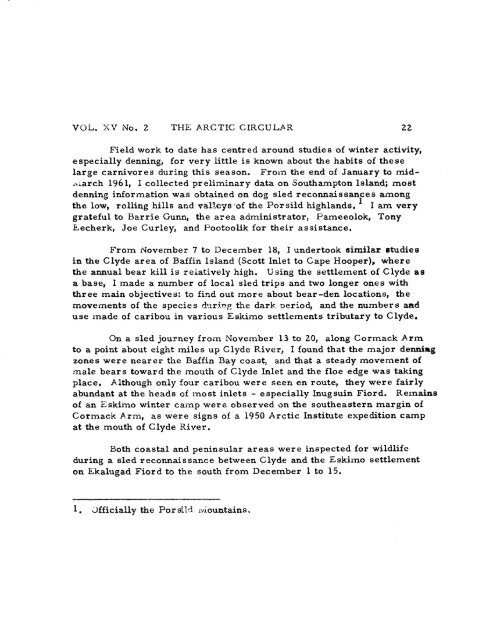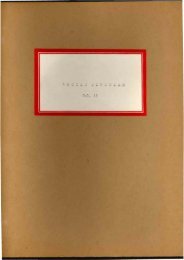A RCTIC CIRCULA NO. I Notes on a trip in l6-foot ... - The Arctic Circle
A RCTIC CIRCULA NO. I Notes on a trip in l6-foot ... - The Arctic Circle
A RCTIC CIRCULA NO. I Notes on a trip in l6-foot ... - The Arctic Circle
Create successful ePaper yourself
Turn your PDF publications into a flip-book with our unique Google optimized e-Paper software.
VOL. iiV No. 2 THE A<str<strong>on</strong>g>RCTIC</str<strong>on</strong>g> <str<strong>on</strong>g>CIRCULA</str<strong>on</strong>g>R zz<br />
Field work to date has centred around stradies of w<strong>in</strong>ter activity,<br />
especially denn<strong>in</strong>g, for very little is known about the habits of these<br />
Iarge carnivores dur<strong>in</strong>g this seas<strong>on</strong>. Frorn the end of January to midrr'it.rch<br />
I961, I collected prelirn<strong>in</strong>ary data <strong>on</strong> Southampt<strong>on</strong> Island; most<br />
denn<strong>in</strong>g <strong>in</strong>formati<strong>on</strong> was obta<strong>in</strong>ed <strong>on</strong> dog sled rec<strong>on</strong>naissanges arn<strong>on</strong>g<br />
the low, roll<strong>in</strong>g hills and virll.eye'of the Porsild highlandr, I I am very<br />
grateful to Barrie Gunn, the alea adrn<strong>in</strong>istrator, Parneeolok, T<strong>on</strong>y<br />
f-echerk, Joe Curley, and Pootoolik for their assistance.<br />
From rYovember 7 to Decernber 18, I undertook cimilar gt\rdiee<br />
ia the Clyde area of Baff<strong>in</strong> Island (Scott Inlet to Cape Hooper), where<br />
the annual bear kill is reiatively high. Us<strong>in</strong>g the settlement of Clyde ae<br />
a base, I rnade a number of local sled <strong>trip</strong>s and two l<strong>on</strong>ger <strong>on</strong>es with<br />
tJrree rna<strong>in</strong> objectives: to f<strong>in</strong>d out more about bear-den locati<strong>on</strong>s, the<br />
movements of the species Curi.ng the dark oeriod and the numbers aad<br />
use rnade of caribou <strong>in</strong> various Eskirno settlements tributary to Clyde.<br />
On a sled journey frorn Novernber 13 to 20, al<strong>on</strong>g Cormack Arrn<br />
to a po<strong>in</strong>t about eight rniles up Clyde River, I found that the major dennirg<br />
z<strong>on</strong>es were nearer the Baff<strong>in</strong> Bay coast, and that a steady movement of<br />
rnale bears toward the mouth of Clyde Inlet and the floe edge was tak<strong>in</strong>g<br />
place. Although <strong>on</strong>ly four caribou were seen en route, tlrey were fairly<br />
abundant at the heads of rnost <strong>in</strong>lets - especially Inugsu<strong>in</strong> Fiord, Rerna<strong>in</strong>s<br />
of an Eskimo w<strong>in</strong>ter ca<strong>in</strong>p were observed <strong>on</strong> the southeastern marg<strong>in</strong> of<br />
Cormack Armr a6 were signs of a 1950 <strong>Arctic</strong> Instihrte expediti<strong>on</strong> camp<br />
at the mouth of Clyde River"<br />
Both coastal and pen<strong>in</strong>sular areas were <strong>in</strong>spected for wildlife<br />
dur<strong>in</strong>g a sled rec<strong>on</strong>naissance between C1yde and the Eskirno settlement<br />
<strong>on</strong> Ekalugad Fiord to the south from Decernber I to 15.<br />
I . Jfficially the Por slld rviounta<strong>in</strong>s.












